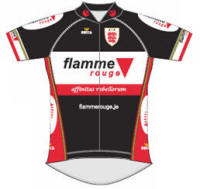Warm-up Routines
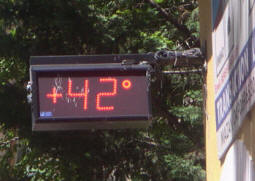
This
factsheet is all about the art, and trust me it is an art, not a
science, of warming up.
If you want to race hard straight from the gun, then you need a good warm-up.
If you want to race harder for longer, then you're going to need a good warm-up.
If you want to survive the first hill, first attack, or first prolonged effort, you need a good warm-up.
If you don't normally get in the groove until the middle of the race, then... you get the message.
If you want to race better, perform better and be around for the sprint at the finish, then you need to warm-up better than the majority of the other riders present. That dear readers is a fact, not an opinion.
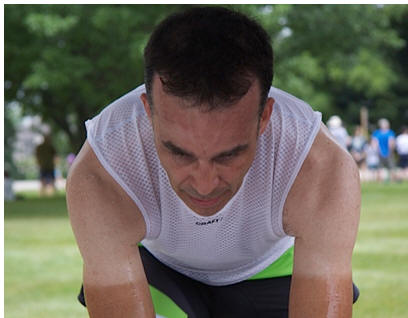
Derek de Gannes preparing for the Canadian
Masters TT Championships
check out those tan lines!
Why warm-up?
For most of us a winter of intense,
military-precision-like preparation precludes each season. It's a
sad fact, and a terrible waste, that very few of us prepare for
individual battles with the same gusto and attention to detail that we
used to prepare for war.
Your body is a complex machine of muscles, fibres, tissue, bones and juices. Just like any other highly complex, well-tuned machine it works better when it's warm; and warming it is a fine art and one to which you should pay attention.
Lessons From Others
Ever watched a Moto GP or Formula 1 race?
Each pilot has their own individual preparation routines (I could go
into neuro-linguistic programming (NLP) but that would take a web site
in itself, maybe some other day). Valentino Rossi crouches into a
ball, and holds the right toe peg of the bike before he gets on and goes down the pit lane clearing obstructions
from the rear soft-tissue area!
Each professional sports person has a routine that can be anything from putting their left sock on before the right or having their favourite motivational tune on their i-pod, while sipping their specially mixed carb-drink, with their scented towel draped over their head to block out visual distractions.
Everything is planned to happen; everything. Nothing is left to chance.
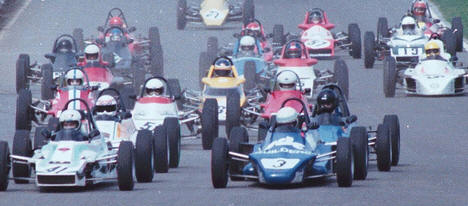
Me, before I had a proper job...
In car racing, the warm-up isn't just an opportunity for the drivers to wave to their adoring public. Drivers leave the line like a scalded cat, to warm the tyres. They move the car violently from side to side, to warm the suspension. They go up and down the gears, to test shift response and warm the oil. They accelerate and brake as hard as possible, to put energy into the vehicle to generate heat.
While doing all this, they mentally attune themselves to their surroundings, the environment and those around them. When the race starts they are as ready as they could ever be both physically and mentally. Because if you're not paying attention it can get awfully messy, awfully quickly.
So, what's this got to do with cycling?
Absolutely everything. A thorough warm up is as vital to your event participation as a front wheel. You're going no where without it.
Think This Through
You need to have a heart that's ready to pump
blood (oxygenated blood), muscles and joints ready to accept it, and a nervous system that's synchronised to co-ordinate muscle and reflex
responses in the correct order and proportion.
You also need to prime your stomach and digestion system to start the internal glucose drip, drip, drip, that you'll need to get you through your event. Sweat glands need to be primed and your breathing rhythmic and settled. All systems need to be go; not just some of them.
And that includes getting your brain in to gear. Especially if it's a time trial, race or sportive, or track race, or cyclo cross, or MTB. Never mind, just get your bloody race head on before you line up!
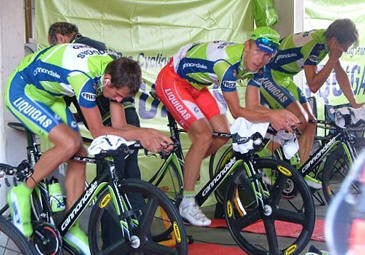
Cold, Warm, Hot ~
Bad, Good, Bad
You can have too much of a good thing.
Riding at 80% of VO2max for
30 minutes will get all of the above physiological responses working but
it would be a terrible warm up.
Turning up in your car, placing the front wheel in the bike, then leaving the line to do a 25 mile TT while you're "fresh", is also a terrible warm up. Hot and cold are bad, only warm is good; everything in moderation!
Each event is different. Paradoxically the longer the event the shorter the warm up. You might take an hour to do a proper warm up for a ten lap crit at the track, yet you might just rub a bit of sports balm on your legs for a 125 mile, neutralised start, cyclosportive.
Just as each event is different, so is each individual's warm-up routine. What is a spot on warm-up for one cyclist could see another's legs full of lactate and a heart rate bouncing off it's rev limiter.
Work out what is good for you, Use the first few events of the year to hone your warm up technique.
Don't just ride out to the race with your mates then do a few ups and downs of the start and finish straight, checking two or three gears as you do, then remembering you haven't had a wee.
There's precious minutes wasted. Now you have to rush to the line panting, hot, but not warmed up!
So if that isn't a warm up, what is?
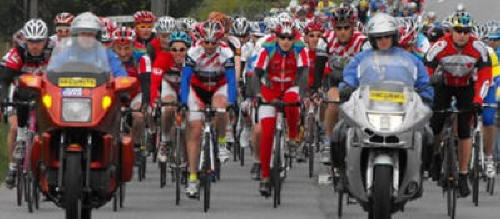
Neutralised section Marc Gomez Sportive
Me, front right, getting warm off the moto exhausts!
Still haven't got a proper job...
A Five Stage
Warm-up Suggestion
As we've said, everyone's different but the same laws of physics and
physiology apply to us all. So do road conditions.
During your warm-up check for road irregularities, damp patches under trees and in braking areas. Watch out for oil on the road, and check farm entrances for "farming-stuff".
Ask yourself, "Will those people working in the fields be leaving during our race?" If the horse droppings that weren't there on the last lap have just appeared, where's the horse? There are hundreds of clues to help you if you allow yourself to see them.
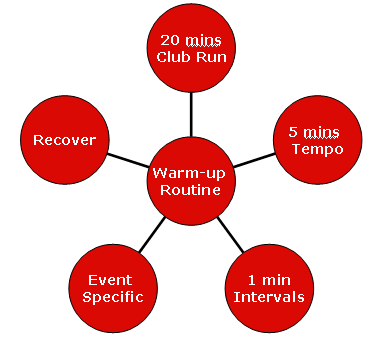
Anyway, to the riding. First you need to give your body a good introduction to the efforts you will shortly be requesting from it in anger. That introduction starts with stage one, at least ten to twenty minutes at winter club run pace on the small ring.
Once your heart rate and body temperature have stabilized, and you don't feel the cold any more, intensity can increase to stage two.
Slip it on the big ring and give it a minute or two at the same speed as stage one. Then, slowwwly increase the speed and gears to finish at the end of five minutes at a good tempo pace. Then it's back on to the small ring to let your body settle down and recover its composure.
Stage three calls for a one minute wind up. Not of your mates, but a wind up to cruising speed. Take two minutes to recover then go again for another minute. By now your heart should be in race running mode and you should be breathing rhythmically and have a slight sweat on.
You shouldn't be gasping for breath with your heart coming through your chest and you shouldn't have any conscious feeling of heavy legs.
Stage four is dependent on the event you're about to undertake.
Time trials
Obviously require a different approach than road races and criteriums. For a time trial, you need to ride at your threshold for the duration of the event.
So a TT warm up requires a steadily increasing intensity, ten minute ride, building up to a VO2max effort in the last minutes. For a 10 mile TT you might consider two of these.
Road Races
Racing requires different physiological responses from your body. Although road races normally start easier than a TT, when the hammer goes down you need to be ready. You may need to climb a hill, chase a break or launch an attack at an early stage in the proceedings.
So, try three or four sprints, of around eight seconds each, just to get the muscles firing in the right order and to clear the soot from your lungs. Take a good three or four minute recovery between each effort. If there is a hill, try an 80% interval on the first part, just to see what happens!
Criteriums!
Anything can, and usually does, happen on the first lap of a crit. There's always someone in the 53x12 while the rest of the race is trying to get their foot in the pedals.
They'll probably come back, but they may not. Whatever happens you need to be ready because if there is a split your race could be over before the end of the first lap.
Try the TT threshold warm up, but obviously your gears will be lower and your cadence (leg speed) higher. After a four of five minute recovery build up to a tempo pace then give it a ten second sprint.
Take a few minutes recovery then do a twenty second, chasing a break effort. After a few more minutes recovery try a thirty second, launching an attack effort.
There we are, all expected race efforts, simulated, tested and passed. Well done you!
Stage five is the same for
all events. Take three to five minutes to recover after your last
effort. Return to the start and take a last minute swig of your
carb drink and, if needed, take a gel or a little food.
Remove
your non-race clothing and put it somewhere dry, have a final check of
tyre pressures, check your pockets for food (in or out depending on the
event), check your race bottles, make sure your number is on and in the
right place, your helmet is done up correctly, your shoes are set and
then clear your mind of all distractions.
You've done everything you can to prepare yourself.
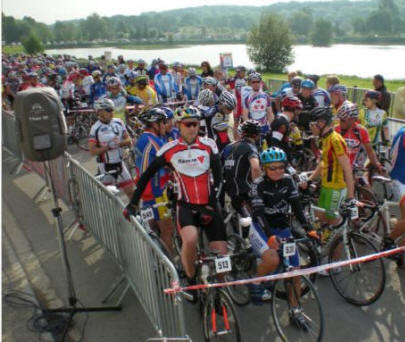
Arrive on the line, in the correct gear for starting (very important and often overlooked), composed, warmed and ready to go.
Listen to the last minute advice from the organiser and think through what you are going to do in the early stages of the event. A perfect warm-up is worth nothing if you're sitting at the back when the break goes! When the start comes position yourself near the front and whatever happens; enjoy your race!
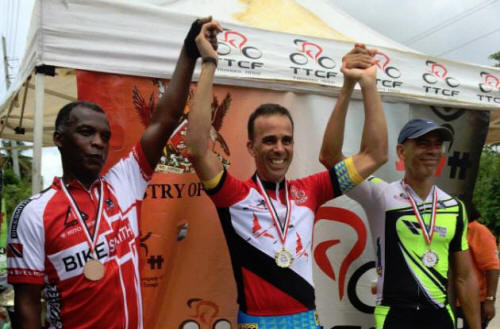
The rewards of a great warm-up routine
Derek de Gannes ~ National Champion, again!
The Message
The quality of your race is dependent on three
factors; your pre-event preparation (physical and nutritional), your
internal mental
attitude and your pre-event warm-up.
If any one of those factors is not 100% spot on, your performance is compromised. You might still win, because someone else is even less prepared, but your individual performance will not be at its full potential.
Like everything else in this website, not all of it will work for you. Take the bits that do work and ignore the bits that don't.
Sorry to have to break this to you, but you're not going to win every race you enter. So choose the less important ones and PLAN a warm-up routine to try and perfect. And write it down, because you won't remember it either before or after!
Use the stages above as a starting point. If they work, great. If not modify them. Whatever you do, don't just turn up and hope to make it up on the day.
Stages one to three can be done on the way to the event.
After you've signed on and done your number, get back on the bike and do stages four and five. Or do one and two, then get your number; the permutations are endless!
Don't start your warm-up, get your number then get chatting and forget the final stages. Because when the race starts the effects will at best be minimised and at the worst, lost completely.
The ultimate message is: plan a routine, try it then modify it until it suits your style. Use non-important races to test and modify the plan.
DON'T try a new routine on your most important race of the year. It's been done and it doesn't work.
Good Luck.

